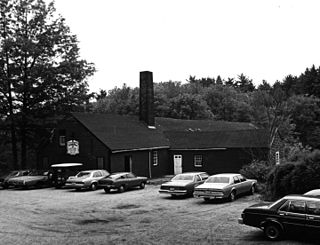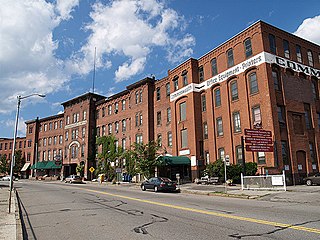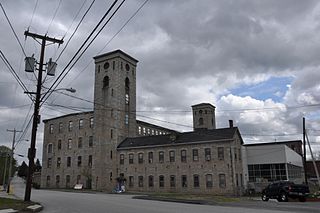
The Bigelow Carpet Company Woolen Mills are a historic mill complex on Main Street in Clinton, Massachusetts. The sprawling mill complex was built or expanded by the Bigelow Carpet Company, one of Clinton's leading business for much of the 19th and early 20th centuries. The complex was listed on the National Register of Historic Places in 1983. It continues to be adaptively reused by smaller businesses.

The Bigelow Carpet Mill is an historic textile mill complex at Union and High Streets in Clinton, Massachusetts. Built in 1847 and repeatedly enlarged until 1922, this large mill complex was one of the world's major early automated manufacturers of Brussels tapestry, established by Horatio and Erastus Bigelow. The mill was listed on the National Register of Historic Places in 1978.

The Tack Factory was a historic industrial facility at 49 Tiffany Road in Norwell, Massachusetts, United States. With its oldest portion dating to 1834, it was the last surviving 19th-century mill building in Norwell prior to its destruction by fire in 1983. It was listed on the National Register of Historic Places in 1980. For most of its history it was used in the manufacture of horse tack equipment.

The Baystate Corset Block is a historic commercial block at 395–405 Dwight St. and 99 Taylor Street in Springfield, Massachusetts, United States. Built in 1874 and twice enlarged, it was from 1888 to 1920 home of the Baystate Corset Company, one of the nation's largest manufacturers of corsets. The building was listed on the National Register of Historic Places in 1983.

The Washburn and Moen North Works District encompass an industrial complex that housed the largest business in Worcester, Massachusetts in the second half of the 19th century.

The Southbridge-Sargent Manufacturing District encompasses a collection of three 19th-century factory buildings near a historically important railroad junction in southern Worcester, Massachusetts. They were built near the intersection of Sargent and Gold Streets, just south of Southbridge Street. The location is close to a junction of three major railroads: the Boston and Albany, the Norwich and Worcester, and the New York, New Haven, and Hartford. The area was once a major industrial part of the city, but has lost many of its historic factory buildings in the 20th century.

The Worcester Corset Company Factory is an historic factory building at 30 Wyman Street in Worcester, Massachusetts in the Main South neighborhood. The oldest part of the factory was built in 1895, with expansion of the facilities taking place up to 1909. The buildings were designed by Arthur F. Gray for the Worcester Corset Company, whose origins date to an 1861 business by David Hale Fanning making hoops for skirts, but shifted to manufacturing corsets after fashions changed. Fanning's business was immensely successful, and he became one of Worcester's larger employers. At one point it employed over 2000 women. After the Corset Company folded in 1940, the facility was used to manufacture military-style boots. The factory is now an apartment complex.

The Whittall Mills is an historic industrial complex in southern Worcester, Massachusetts. The complex, which was built between 1870 and 1930, is a reminder of the large carpet manufacturing business that was once a major presence in the city. It is a complex of 15 brick buildings located on a bend of the Middle River, south of Crompton Street and just west of Interstate 290.

The Brightside Apartments is a historic apartment house at 2 King Street in Worcester, Massachusetts. Built in 1888 to a design by Fuller & Delano, it is one of southern Worcester's finest 19th century apartment blocks. The building was listed on the National Register of Historic Places in 1980, even though it had recently experienced some damage due to a minor fire.

The Crompton Loom Works is an historic industrial complex of the Crompton Corporation at 132-142 Green Street in Worcester, Massachusetts. The factory manufactured looms for textile factories. With its original portion dating to 1860, the complex is one of the oldest surviving industrial sites in the city. The facility was established by George Crompton, whose father William had invented the first power loom for weaving fancy fabrics. The younger Crompton's business would become of the most significant employers in the city, and his innovative looms would revolutionize the textile industry. Crompton and his successors would operate the loom manufacturing works at Green Street well into the 1960s. The manufacturing capabilities on the site were applied to producing can packaging machines and bowling pinsetters. Capabilities at the Green Street facility included machining, drop hammer forging, a cast iron foundry, wood working. and pattern making, along with a materials testing lab.. The building has subsequently been adapted to other uses. The complex was listed on the National Register of Historic Places in 1980, and included as part of the Blackstone Canal Historic District in 1995.

The Hammond Organ Reed Factory is a historic former factory building at 9 May Street in Worcester, Massachusetts. Built in 1868 and enlarged in 1886, it is one of the city's few surviving Second Empire factory buildings. It was listed on the National Register of Historic Places in 1980. In 2007–2009, the building was restored and converted for use as affordable housing.

The Harding-Winter Street Manufacturing District encompasses a surviving fragment of the 19th century industrial history of Worcester, Massachusetts. The district includes seven brick factory buildings which were built between 1870 and 1898. They are a remnant of a once-extensive manufacturing district that extended further along Franklin and Grafton Streets, but has become fragmented by urban redevelopment and the construction of nearby Interstate 290. The district is bounded on the south by Pond Street, on the west by Harding Street, on the east by Water Street, and on the north by the rear property lines of Winter Street properties. The district was listed on the National Register of Historic Places in 1980.

The Marcus Hobbs House is an historic house at 16 William Street in Worcester, Massachusetts. Built in 1849, it is an example of mid-19th century Greek Revival housing with added Italianate features. The house was listed on the National Register of Historic Places in 1980.

The Junction Shop and Hermon Street District is a historic district comprising 28 industrial properties on Jackson, Hermon, and Beacon Streets on the south side of Worcester, Massachusetts. It is a remnant of a once larger 19th and early 20th century manufacturing district just west of the railway junction between the Boston and Maine Railroad and the New York, New Haven and Hartford Railroad. It was listed on the National Register of Historic Places in 1980.

The Central Mills Historic District encompasses a historic mill complex on the Quinebaug River in central Southbridge, Massachusetts. Located at the corner of Foster and North Streets, the site consists of three brick buildings, the oldest of which has portions dating to 1837. Despite being extensively rebuilt in the early 20th century, the complex has an appearance that is more typical of 19th century mills.

The Hamilton Woolen Company Historic District encompasses the well preserved "Big Mill" complex of the Hamilton Woolen Company, built in the mid 19th century. Located at the confluence of McKinstry Brook and the Quinebaug River in central Southbridge, Massachusetts, the complex consists of a cluster of mill buildings and a rare collection of 1830s brick mill worker housing units located nearby. The district was listed on the National Register of Historic Places in 1989.

The Kraus Corset Factory is a historic industrial property at 33 Roosevelt Drive in Derby, Connecticut, United States. The oldest portion of the large brick building, built in 1879, faces Third Street, while a c. 1910 addition extends along Roosevelt Drive. It is the only major building to survive from Derby's period of corset manufacturing. It was built by Sidney Downs, one of Derby's leading businessmen of the period. The building was listed on the National Register of Historic Places on February 12, 1987. It has been converted into apartments.

The Stevens Linen Works Historic District encompasses a 19th-century factory complex associated with the manufacturing of linen and flax fabric in Dudley, Massachusetts. Its centerpiece is the Stevens Linen Mill, built in the 1860s by Henry Hale Stevens and operated into the mid-20th century. The mill is a large granite U-shaped building, five stories high, with two seven-story towers at the corners of the U. The complex includes ten buildings in all, as well as a mill pond and dam.

Colony's Block is a historic commercial building at 4-7 Central Square in the heart of Keene, New Hampshire. The five-story brick building was built in 1870 to a design by Worcester, Massachusetts, architects E. Boyden & Son, and is the city's most prominent example of Second Empire architecture. In addition to being a long-standing commercial center, the building housed the city library from 1870 to 1877. The building was listed on the National Register of Historic Places in 1983.

The Main and Franklin Streets Historic District is an historic district encompassing most of two city blocks in downtown Worcester, Massachusetts. Roughly bounded by Main, Franklin, Federal, Portland, and Salem Streets, the district includes a well-preserved concentration of commercial buildings constructed during Worcester's economic height in the late 19th and early 20th centuries. The district was listed on the National Register of Historic Places in 2022.























